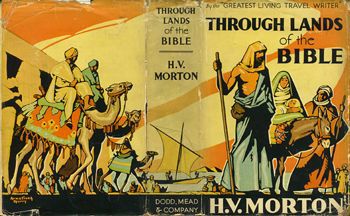Is there a person in America who at one time oor another has not turned from the
pages of the Bible with a far-away look in his eyes to conjure up pictures of its
hills and cities, its rivers and plains and temples?
H.V. Morton decided some years ago to set out upon a journey -- a series of journeys
if necessary -- and visit, in his own way, the "lands of the Bible." It
has taken time to accomplish this extraordinary quest, and it has taken patience
and persistence in the face of difficulties that were sometimes amusing and sometimes
heartbreaking. In this book he tells the story of his experience, and in telling
it, he takes the reader with him, every step of the way; to watch the subset on the
broad Euphrates, to smell the fragrances of spring in the Sinai mountains, to listen
to the joyous din of an Egyptian market place, to relive the unforgettable events
of the Bible in their modern settings.
The scope of this book is remarkable.t begins at Alexanderia, in Syria, and continues
by way of Aleppo to Bagdad, Babylon, and Ur of the Chaldees. The author then takes
you through Palestine to Egypt. He journeys to Sinai, where he stayed at the monastery
of St. Catherine, the oldest inhabited monastery in the world. Among out-of-the-way
places described is the Oasis of Siwa, famous for its association with Alexander
the Great, and almost unknown until the Great War*. The description
of the Coptic monasteries of the Wadi Natrun, in Egypt, is the first modern account
of daily life in those strongholds of primitive Christianity. The book ends with
a description of Apostolic sites in Rome, where the author spent Easter week.
